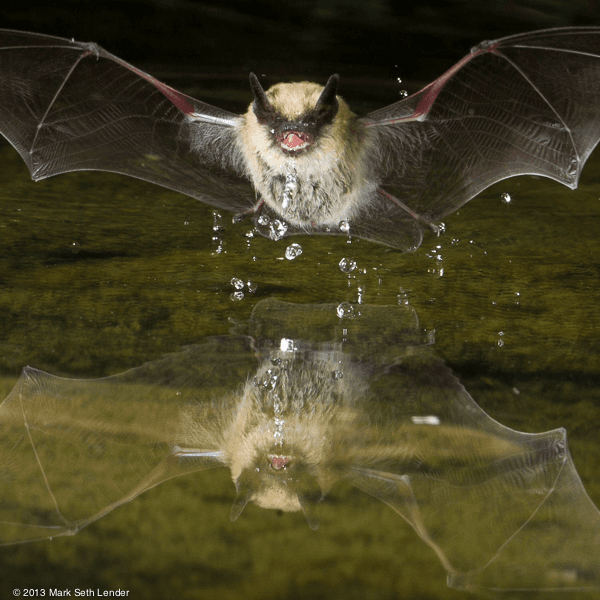Bats Seeking Water
CURWOOD: Well, from the forested northeast we go to the parched west, currently suffering from a severe drought. And as Mark Seth Lender observed in southern Arizona, summer heat is making things extremely hard for some wildlife.
[Bats Seeking Water 2013 Mark Seth Lender All Rights Reserved]
Driving down from Madera Canyon the land opens its mouth. Saw-toothed mountains in the distance are the teeth, broken and chipped, the yawning of an ancient Beast; and the hot sweet breath of him. It sucked the moisture out of here a long time ago. The jaws can no longer close. The palate of the land, exposed, is chafed and raw. A last meal clings there: lesser hills and spent volcanic cones, their rounded forms like desiccated corpses of giant and of giantess, weathering, all but worn away.
Dust blows.
It hurts to inhale.
The quest for water is everything.
At night when the air is utterly still and the birds sleep, the insects begin; desert flowers open to their song. And by that scent and sound the bats are stirred to wakefulness. They yawn then stretch their membranous wings, hungry for the food that bloom and pollinator provide.
Nectar, Pallid and Free-tail bats search for water. (Photo: Mark Seth Lender)
But it is Thirst, Thirst that rules the land. Open-mouthed the bats fly, out from their hidden perches and caves in the ground, parched and persistently seeking. Above the din of odors and the roar of edible things the vital element calls. A pool in the desert, rare and lustrous and of value second only to breathing: a narrow place, a small place and shallow in the dark and the water is sweet and waiting. Months if not years it took to find. Many intolerable nights and burning days of searching. Having found, they will visit like a shrine.
Bats emerge in the evenings when its cooler than an Arizona day in search for food and water. (Photo: Mark Seth Lender)
Dipping and sipping they come, aligned for the longest angle of glide, for the sureness of scooping and rising. Nectar bats, the length of their pink tongues extended as far as they will go. Pallid bats, tall ears cupping sound as their mouths cup water. Free-tails, the wingtips like twin oars splashing and spraying, and water dripping from their chins. A moth dives for cover preferring the risk of drowning to the risk of bats in the air. The bats ignore her. They are of one mind and one purpose only. To drink. And drink and drink.
Nectar, Pallid and Free-tail bats have long tongues in order to drink and eat insects and pollen. (Photo: Mark Seth Lender)
South and west of Madera, out in the Sonoran Desert, on the flat of the land and the flank of the hills, saguaro stand. They march on the mountain until the scree defeats them, too steep even for saguaro to root and hold. It is not their cactus thorns or their outstretched arms that makes them brave. Their very presence is a heroic thing; that any green thrives in all this emptiness of land, of fractured stones, of turbulent sand-blown sky.
Bats glide, hovering above the water just before drinking. (Photo: Mark Seth Lender)
At 110 degrees they prosper, white and yellow flowers, red-ripe fruit split open in the sun; at 120 in the shade, what then?
CURWOOD: Mark Seth Lender was able to photograph bats drinking in pitch dark using Bill Forbess Phototrap. To see the pictures, flutter on over to our website, LOE.org.
